Le guide ultime du palais mental (05 étapes pour le créer et le mettre en application dés aujourd’hui)
Publié · Mis à jour
La méthode du palais mental (Loci) est de loin l’une des méthodes les plus célèbres et les plus utilisées quand il s’agit de technique de mémorisation,
Dans cet article je vais vous montrer les 05 étapes pour créer votre premier palais et le mettre en application dès aujourd’hui
Mais avant d’entrer dans les détails expliquant avant le principe de la méthode
1– Le principe de la méthode du palais mental
Le principe de base est de transformer des objets ou endroits que vous connaissez très bien en objet de stockage
Qu’est-ce qu’un objet de stockage ?
Pratiquement toutes les méthodes de mémorisation que je détaille dans ce blog se basent sur ce principe

Convertir une information en une image pour mieux la mémoriser
Exemple
Votre langue est composée de huit muscles entrelacés
Cette information sera maintenant convertie en image
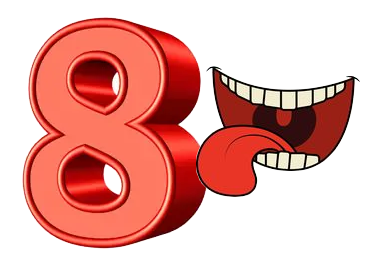
L’information convertie en images sera placée dans un endroit.
Cet endroit est ce que j’appelle un objet de stockage.
Pourquoi avons-nous besoin d’un objet de stockage ?
Imaginez que vous ayez 100 images comme celles ci-dessus représentant 100 informations sur le corps humain
Il est impossible de toutes les garder en mémoire si on ne trouve pas un moyen pour les stocker,
C’est tout le principe de la méthode du palais
La méthode du palais vous permet d’identifier facilement des objets où stocker vos images
2- Identifier les objets de stockage dans son palais mental
Maintenant que vous avez compris le principe de la méthode du palais,
On va voir les étapes pour créer son premier palais mental
Etape 01 : Identifier son palais
Plusieurs endroits peuvent être utilisés comme palais mental
Mais pour débuter le meilleur palais à utiliser sera Votre maison
Nous allons ainsi utiliser votre maison pour identifier des objets de stockages
Etape 02 : Identifier le début et la fin de son palais
Imaginant que ceci représente votre maison vue d’en haut
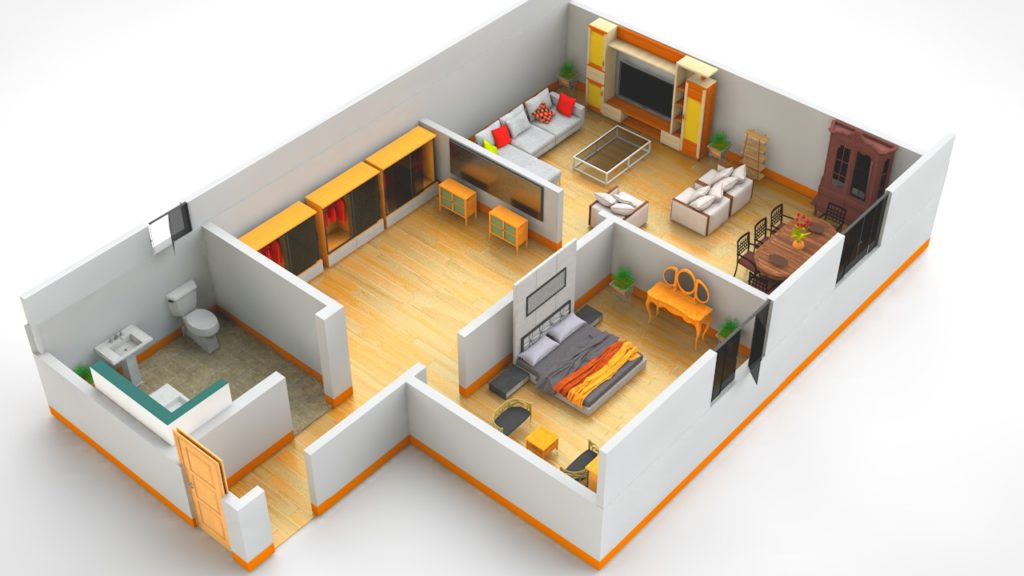
Ce que vous allez faire c’est choisir un endroit de départ et un endroit de fin de votre palais.
Endroit de départ
Le plus simple est d’utiliser la porte d’entrée de votre maison comme endroit de départ.
C’est par là que commencera votre palais

La porte d’entrée sera aussi votre premier objet de stockage
Endroit de fin du palais
L’endroit de fin de votre palais sera le dernier objet de stockage que vous allez utiliser
Là aussi le plus simple est d’utiliser l’objet le plus éloigné de la porte d’entrée
Dans l’exemple ici ça sera l’armoire au fond

Etape 03 : Choisir les objets de stockage
L’étape suivante est de vous imaginer vous balader dans votre maison en partant de la porte et arrivant jusqu’au dernier objet
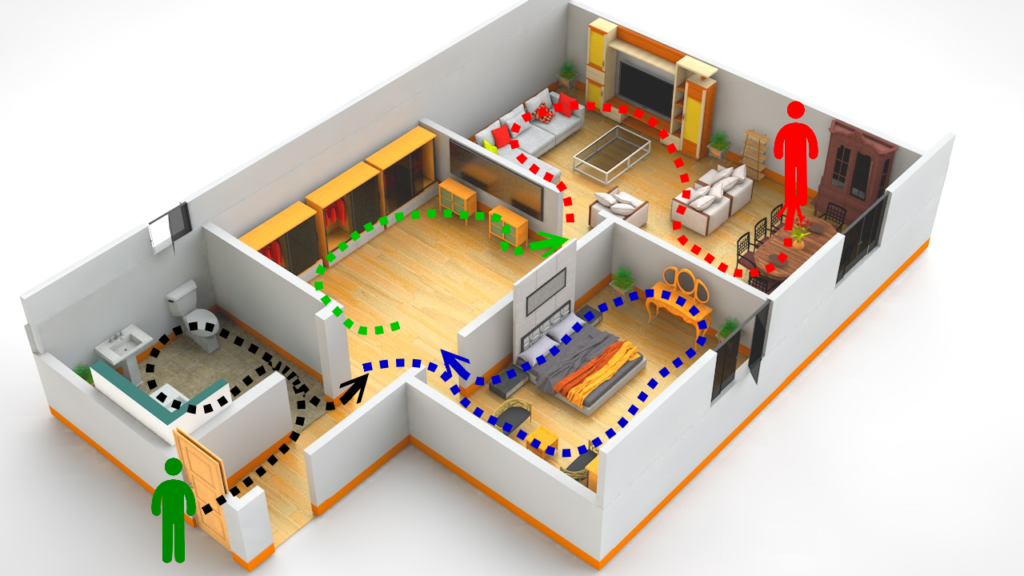
La raison pour laquelle nous avions choisi un endroit de départ et de fin
C’est pour identifier le meilleur moyen de parcourir votre palais
En vous imaginant traverser votre maison, vous allez identifier des objets à utiliser

Dans cet exemple j’ai réussi à identifier 20 objets de stockage
Attention
N’utilisez pas de palais virtuel comme dans l’image, il faut utiliser votre propre maison pour identifier les objets.
Les objets choisis seront classés selon un ordre bien précis
La porte est le premier objet de stockage
Les autres seront numérotés suivant votre parcours de la porte au dernier objet de stockage

Etape 04 : Mémoriser la structure de votre palais
Ce qui rebute le plus dans la méthode du palais c’est qu’il faut mémoriser le palais créé
On voit cette étape comme une corvée supplémentaire qui s’ajoute à notre travail
MAIS
Bien que ça puisse prendre un peu de temps pour créer et mémoriser votre palais mental
C’est un investissement qui vous servira pendant le reste de votre vie
J’ai personnellement créé mon premier palais mental en 2012, et je l’utilise encore à ce jour pour y stocker des informations
Créer et mémoriser un palais mental n’est jamais une perte de temps,
Au pire vous aurez toujours des objets libres où stocker de nouvelles informations
Comment mémoriser son palais mental ?
Il y a deux méthodes toutes simples pour mémoriser votre palais rapidement
1-L’écrire
2-L’utiliser
1- Ecrire
En identifiant vos objets de stockage il est important de les écrire en même temps
Ceci permet à la fois de mieux les structurer et plus important encore de les mémoriser
Vous aurez toujours un papier au quel revenir en cas d’oubli
Par exemple en partant du palais virtuel
1- La porte d’entrée
2- Douche
3-Lavabo
4-WC
5-Fenêtre
6- Chaise
…etc.
2- Utiliser
L’un des moyens les plus rapides que j’ai trouvés pour mémoriser un palais est de l’utiliser après l’avoir créé
L’utiliser signifie simplement que vous allez y placer des informations
Exemple
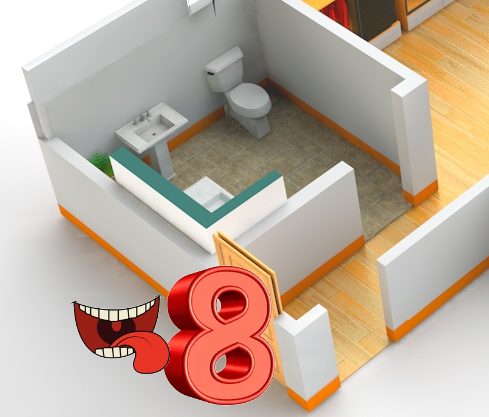
Il est plus facile d’imaginer une langue qui lèche un gigantesque 08 devant votre porte d’entrée que d’imaginer simplement une porte
Quand vous utilisez votre palais vous mémorisez plus facilement les objets de stockage parce que vous les liez à des animations étranges et mémorables
05 Points importants à respecter pour la création du palais mental
Il y a certains points essentiels à prendre en considération quand vous cherchez à créer votre palais mental
01-Quels types d’objets choisir pour mon palais ?
Commencez par utiliser principalement les gros objets faciles à visualiser
La porte
La machine à laver
La télévision
La table
Eviter les objets trop petits pour être bien visualisés
Un interrupteur
Une brosse à dent
Des clés
Une cuillère
02-Combien d’objets choisir par chambre ?
Le mieux est de choisir le même nombre d’objets par chambre
Cela permet une meilleure organisation des informations mémorisées,
Si c’est votre premier palais commencez par 05 objets
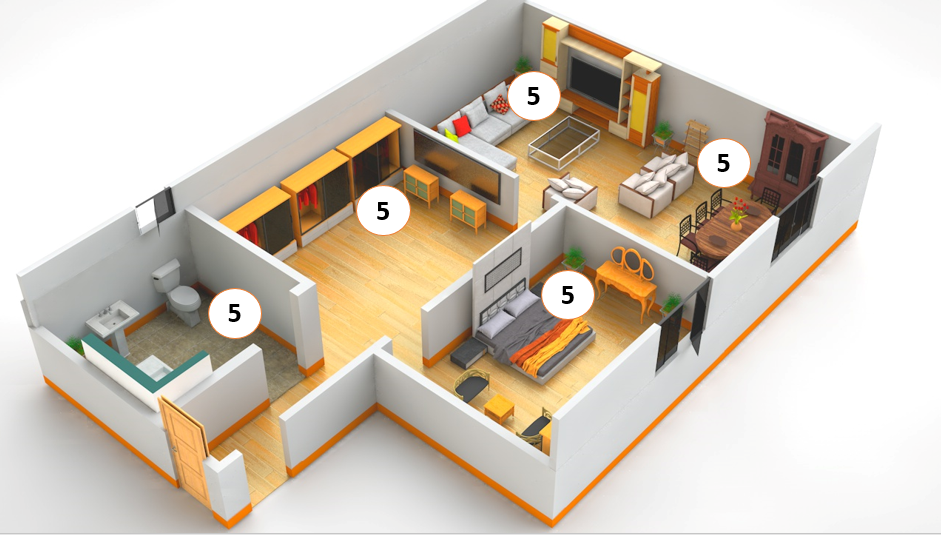
Vous pourrez augmenter le nombre d’objets dans chaque chambre par la suite
03-Est-il possible d’utiliser un même objet plusieurs fois ?
Par exemple votre maison ne contient probablement pas qu’une seule chaise
Est-il possible d’utiliser toutes les chaises de votre maison comme objet de stockage ?
Ou cela va-t-il porter à la confusion ?
La réponse à cette question est
Cela dépend de l’emplacement de l’objet
Prenant l’exemple d’une table à manger
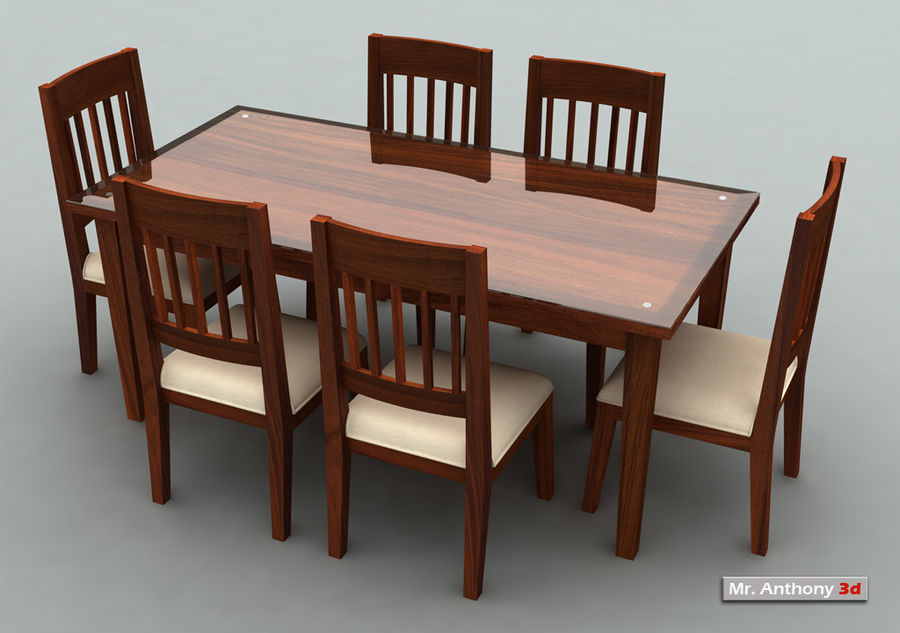
Bien qu’elle contienne 05 chaises, il est préférable d’en utiliser qu’une seule ou grand max 2 comme objet de stockage
Ici les objets (chaises) sont à la fois très similaires et très proches, ce qui rend difficile leur visualisation.
Si je devais choisir des objets de stockage en partant de cette table à manger, voilà comment je vais procéder
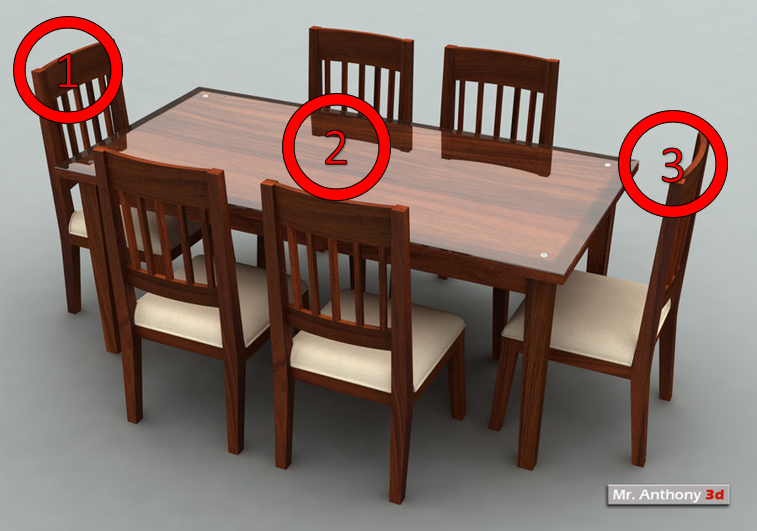
Je choisis la chaise de gauche, la table, et la chaise de droite.
Par contre contrairement aux chaises, chaque porte de ma maison est utilisée comme objet de stockage
Parce que
Chaque porte est dans un endroit différent et éloigné des autres, leur visualisation est donc plus simple
Utilisez toujours ce principe lors du choix de vos objets de stockage
04-Combien est-il possible d’identifier d’objets de stockage dans un palais ?
Il n’y a pas vraiment de nombre précis à respecter, mais sachez que
Plus votre palais contient d’objets de stockage plus vous pourrez y mettre plus d’informations
Votre objectif serait de pouvoir identifier de 50 à 100 objets dans votre maison
Par exemple dans ma maison j’ai réussi à identifier 120 objets de stockage
En pratique cela me permet de mémoriser un minimum de 120 informations

Bien sûr en utilisant les autres techniques le nombre d’informations qu’on peut mémoriser sera doublé ou triplé
05-De combien de palais j’aurais besoin ?
Là aussi il n’y a pas de réponse exacte
Cela dit plus vous aurez de palais disponible plus vous pourrez mémoriser d’informations rapidement
Mais si je devais recommander un chiffre je dirais au minium 03 palais avec une centaine d’objets de stockage chacun
Pour ma part ces 03 palais sont
Ma maison
La maison de mon oncle
La maison de mon ami
Conclusion
Bien que cet article soit long, je n’ai qu’effleuré la puissance de cette méthode,
Et je vais évidemment vous parler des autres aspects de son application dans de prochains articles


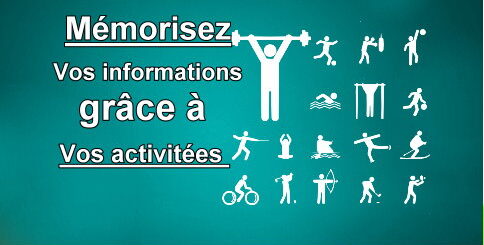

http://rainbow-rainbow.com/?wptouch_switch=desktop&redirect=http%3a%2f%2fwww.google.si%2Furl%3Fq%3Dhttps://urbanhomeworks.org/news/melbet_promo_code_use_this_code_for_130_bonus.html
узнать больше Здесь mega зеркала
зайти на сайт mega зеркала
Xavier completes thrilling comeback, Mount St. Mary’s advances as men’s First Four comes to a close
changenow exchange
Wednesday saw the men’s First Four come to a close which means only one thing: the 64-team bracket is officially set following No. 11 Xavier’s thrilling come from behind win over No. 11 Texas and No. 16 Mount St. Mary’s victory over No. 16 American in Dayton, Ohio.
The Musketeers trailed by as many as 13 points, but their offense came alive in the second half behind guard Marcus Foster and forward Zach Freemantle to down the Longhorns 86-80.
The senior Foster scored a team-high 22 points while Freemantle, on his way to 15 points, threw down a dunk with a second left to seal the comeback win and ignite the fans at UD Arena, which is just over 50 miles away from campus in Cincinnati, Ohio.
With just under four minutes remaining, Xavier went on an 8-2 run to take a 78-74 lead, their first since the early going of the first half.
Musketeers head coach Sean Miller crowned Wednesday’s game as “one of the best” he’s been a part of.
“I thought we were dead in the water two different times,” Miller told the truTV broadcast after the game. “But that’s the one thing about our team — the resiliency of our group has always won out for us. Just when you thought we weren’t gonna make the tournament, we kept winning. Even in this game, just when you’re like, ‘It’s not gonna work out,’ we have a funny way of staying with it.”
The Longhorns did not go down without a fight as guard Tre Johnson scored a game-high 23 points in the loss.
Xavier will face No. 6 Illinois in the first round on Friday at the Fiserv Forum in Milwaukee.
A librarian ran off with a yacht captain in the summer of 1968. It was the start of an incredible love story
metamask wallet
The first time Beverly Carriveau saw Bob Parsons, she felt like a “thunderbolt” passed between them.
“This man stepped out of a taxi, and we both just stared at each other,” Beverly tells CNN Travel today. “You have to remember, this is the ‘60s. Girls didn’t stare at men. But it was a thunderbolt.”
It was June 1968. Beverly was a 23-year-old Canadian university librarian on vacation in Mazatlan, Mexico, with a good friend in tow.
Beverly had arrived in Mazatlan that morning. She’d been blown away by the Pacific Ocean views, the colorful 19th-century buildings, the palm trees.
Now, Beverly was browsing the hotel gift store, admiring a pair of earrings, when she looked up and spotted the man getting out of the taxi. The gift shop was facing the parking lot, and there he was.
“I was riveted,” says Beverly. “He was tall, handsome…”
Eventually, Beverly tore away her gaze, bought the earrings and dashed out of the store.
“We locked eyes so long, I was embarrassed,” she says.
No words had passed between them. They hadn’t even smiled at each other. But Beverly felt like she’d revealed something of herself. She felt like something had happened, but she couldn’t describe it.
Beverly rushed to meet her friend, still feeling flustered. Over dinner in the hotel restaurant, Beverly confided in her friend about the “thunderbolt” moment.
“I told my girlfriend, ‘Something just happened to me. I stared at this man, and I couldn’t help myself.’”
Then, the server approached Beverly’s table.
“He said, ‘I have some wine for you, from a man over there.’”
The waiter was holding a bottle of white wine, indicating at the bar, which was packed with people.
As a rule, Beverly avoided accepting drinks from men in bars. She never felt especially comfortable with the power dynamic — plus, she had a long-term partner back in Canada.
“I had a serious boyfriend at home and thought my life was on course,” she says.
The world’s largest architectural model captures New York City in the ’90s
aerodrome finance
The Empire State building stands approximately 15 inches tall, whereas the Statue of Liberty measures at just under two inches without its base. At this scale, even ants would be too big to represent people in the streets below.
These lifelike miniatures of iconic landmarks can be found on the Panorama — which, at 9,335 square feet, is the largest model of New York City, meticulously hand-built at a scale of 1:1,200. The sprawling model sits in its own room at the Queens Museum, where it was first installed in the 1960s, softly rotating between day and night lighting as visitors on glass walkways are given a bird’s eye view of all five boroughs of the city.
To mark the model’s 60th anniversary, which was celebrated last year, the museum has published a new book offering a behind-the-scenes look at how the Panorama was made. Original footage of the last major update to the model, completed in 1992, has also gone on show at the museum as part of a 12-minute video that features interviews with some of the renovators.
The Queens Museum’s assistant director of archives and collections, Lynn Maliszewski, who took CNN on a visit of the Panorama in early March, said she hopes the book and video will help to draw more visitors and attention to the copious amount of labor — over 100 full-time workers, from July 1961 to April 1964 — that went into building the model.
“Sometimes when I walk in here, I get goosebumps, because this is so representative of dreams and hopes and family and struggle and despair and excitement… every piece of the spectrum of human emotion is here (in New York) happening at the same time,” said Maliszewski. “It shows us things that you can’t get when you’re on the ground.”
Original purpose
The Panorama was originally built for the 1964 New York World’s Fair, then the largest international exhibition in the US, aimed at spotlighting the city’s innovation. The fair was overseen by Robert Moses, the influential and notorious urban planner whose highway projects displaced hundreds of thousands New Yorkers. When Moses commissioned the Panorama, which had parts that could be removed and redesigned to determine new traffic patterns and neighborhood designs, he saw an opportunity to use it as a city planning tool.
Originally built and revised with a margin of error under 1%, the model was updated multiple times before the 1990s, though it is now frozen in time. According to Maliszewski, it cost over $672,000 to make in 1964 ($6.8 million in today’s money) and nearly $2 million (about $4.5 million today) was spent when it was last revised in 1992.
The fish collectors hoping to save rare species from extinction
phantom wallet
In the rural town of Petersham, Massachusetts, 78-year-old Peter George keeps 1,000 fish in his basement.
“Baseball, sex, fish,” he says, listing his life’s great loves. “My single greatest attribute is that I am passionate about things. That sort of defines me.”
All of George’s fish are endangered Rift Lake cichlids: colorful, freshwater fish native to the Great Lakes of East Africa. Inside his 42 tanks, expertly squeezed into a single subterranean room, the fish shimmer under artificial lights, knowing nothing of the expansive waters in which their ancestors once swam, thousands of miles away.
Due to pollution, climate change and overfishing, freshwater fish are thought to be the second most endangered vertebrates in the world. In Lake Victoria, a giant lake shared between Kenya, Uganda and Tanzania, over a quarter of endemic species, including countless cichlids, are either critically endangered or extinct.
But for some species, there is still hope. A community of rare fish enthusiasts collect endangered species of freshwater fish from the lakes and springs of East Africa, Mexico and elsewhere, and preserve them in their personal fish tanks in the hope that they might one day be reintroduced in the wild.
“I’m a hard ass,” George says. “There is hope.”
Insurance
George has been collecting fish since 1948 when, as a four-year-old in the Bronx, he would look after his grandmother’s rainbow fish. He soon developed “multiple tank syndrome” – a colloquial term used by fish collectors to denote the spiral commonly experienced after acquiring one’s first tank, which involves the sufferer buying many more tanks within a short space of time. He has not stopped collecting since.
Now, George sees himself as a conservationist; his tanks contain what is known as “insurance populations” – populations of endangered fish that are likely to go extinct in their natural habitats. He believes that when the time is right, they can be taken from his collection and returned to their homes. “I would never accept the fact that they couldn’t be reintroduced,” he says.
кликните сюдаКупить скрипт хайпа
такой
goldcoders
взгляните на сайте здесь
Купить скрипт хайпа
Noon Capital is revolutionizing real estate crowdfunding by offering secure, decentralized, and high-yield investment opportunities. Through blockchain-powered property financing, Noon Capital investment platform allows investors to participate in fractional real estate ownership, earn passive income, and diversify their portfolios with full transparency and security. Whether you’re an institutional investor or an individual seeking real estate-backed DeFi solutions, Noon Capital provides a seamless and profitable investment experience. https://noon.ad
GUD Tech is at the forefront of blockchain innovation, providing secure, scalable, and efficient decentralized technology solutions. Whether you’re looking for blockchain infrastructure, smart contract development, or enterprise-grade decentralized applications, GUD Tech offers cutting-edge solutions to enhance security and efficiency. Designed for businesses and developers, GUD Tech ensures seamless integration of blockchain technology into real-world applications. https://gudchain.net
HyperDrive is transforming the way data is stored and managed through decentralized storage and blockchain hosting solutions. Built for security, scalability, and efficiency, HyperDrive enables businesses, developers, and blockchain projects to store and distribute data without relying on centralized servers. By leveraging Web3 technology and distributed networks, HyperDrive ensures reliable, censorship-resistant, and high-performance storage solutions for the digital era. https://hyperdrive.ink
Flaunch is the leading blockchain gaming launchpad, designed to help game developers and investors thrive in the Web3 gaming ecosystem. By offering secure token launches, NFT integrations, and decentralized crowdfunding, Flaunch enables game creators to fund, develop, and scale their projects with full transparency and community-driven support. Whether you’re a developer or an investor, Flaunch provides the tools to connect and grow in the blockchain gaming space. https://flaunch.tech
Elara Finance is transforming decentralized lending by offering secure, transparent, and flexible crypto loan solutions. Built on blockchain technology, Elara Finance enables users to borrow and lend digital assets seamlessly without intermediaries. With low-interest rates, automated smart contracts, and a permissionless DeFi environment, Elara Finance is making crypto lending accessible and profitable for investors worldwide. https://elara.ink
DEQ Finance is revolutionizing decentralized trading by offering a seamless, secure, and efficient crypto exchange experience. Built with cutting-edge blockchain technology, DEQ Finance provides traders with fast transaction speeds, deep liquidity, and a transparent trading environment. Whether you’re a beginner or a professional trader, DEQ Finance delivers high-performance DeFi solutions tailored to modern trading needs. https://deq.li
интернет https://maps.google.dz/url?q=https://travelanswer.ru/questions/kak-obnovity-iin-pri-istecenii-zagranpasporta-i-sohranity-scet-v-kaspi.html
Источник https://images.google.ie/url?q=https://iskrahall.ru/
my sources zkLogin
her explanation zkLogin